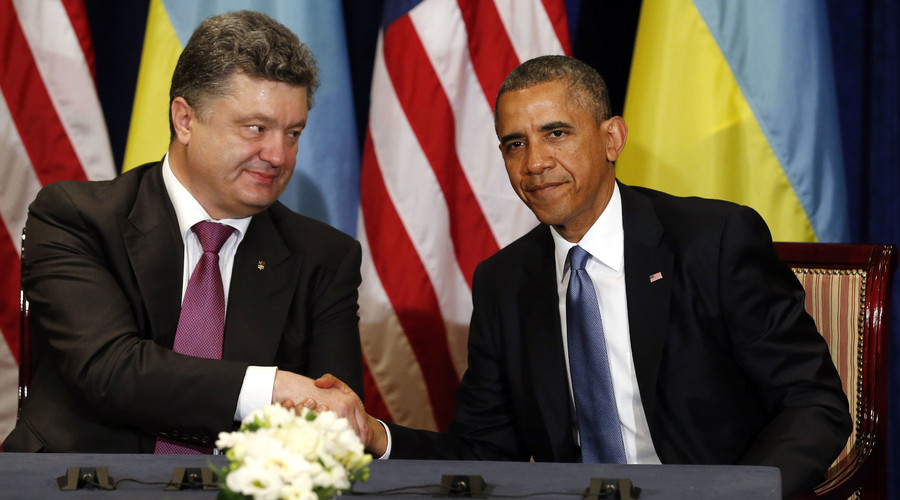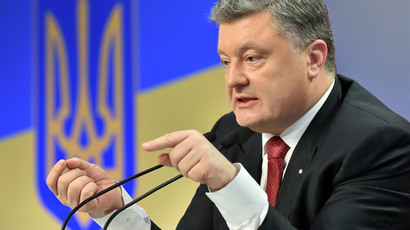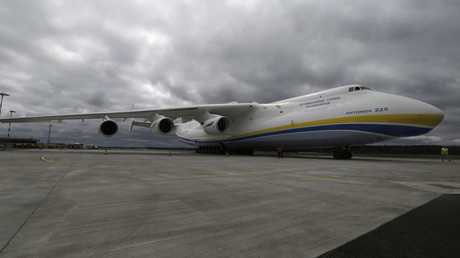Modern Ukraine is 25 yrs old, but is it actually independent?
Bryan MacDonald is an Irish journalist, who is based in Russia
Ukraine celebrates the 25th anniversary of its succession from the Soviet Union this week. But, after years of struggle and division is it truly independent?
March 2014 was arguably the most dramatic and pivotal month in Kiev since Ukraine seceded from the USSR. The country’s democratically elected government had been overthrown in a violent coup (considered to be a revolution in the West) and the new regime was struggling for legitimacy. Especially after a leaked phone callbetween the US Ambassador Geoff Pyatt, and State Department representative Victoria Nuland, seemed to suggest external actors had dictated its make-up.
Adding to the tumult, Crimea had just voted to separate and re-unite with Russia in a hastily organized referendum, (which is regarded as an annexation by much of the West) and Donbass witnessed clashes between pro-Maidan protestors and others who opposed the movement. At this moment, Ukraine was on fire and needed all the support it could muster.
Except that backing never came, despite gaggles of Western politicians showing up in Kiev in early 2014 pledging solidarity with activists who sought to remove President Yanukovich. Two and a half years later, Ukraine has received minimal aid from Western countries and is no closer to EU membership than it was then. In fact, even the promised visa-free travel arrangement with Schengen countries has yet to materialize.
Sharp analysts have long suggested that Western power brokers aren’t that dedicated to helping Ukraine. Instead, the argument goes, the priority seems to be hurting Russia. This week, via a DC Leaks dump of billionaire Hungarian investor George Soros’ communications; we have new evidence to support that argument. What’s also interesting is that when Russia ejected Soros’ NGOs, Western reaction was apoplectic. DC Leaks' revelations suggest President Putin’s move to block these groups might have been sound strategy.

Hurting Russia or helping Ukraine?
On the last day of March in 2014, according to the files, Ambassador Pyatt sat down for breakfast with billionaire Soros and a group of lobbyists he employs to push his agenda in Eastern Europe. What is most startling about the conversation is the total lack of regard for Ukrainian interests and the obsessive focus on Russia. It’s also instructive as to how Western influencers regard Ukraine. More as a buffer against Moscow than as a country with rightful aspirations of its own.
At one stage Pyatt asks Soros, “what (the) USG (US government) should be doing and what the USG is currently doing (sic)?” The reply is “Obama has been too soft on Putin,” and he goes on to suggest “a division of labor between the US and the EU with the US playing the bad cop role” in dealing with the Kremlin. It’s all Putin, Putin, Putin and continues in this vein. The only mention of Ukraine is when Pyatt and Soros agree to remove Yulia Timoshenko from the equation.“Timoshenko is associated with everything undignified,” the ambassador states.
Now, we are all entitled to an opinion on Timoshenko. But her political party Fatherland is currently the most popular in Ukraine and it’s up to Ukrainians to decide whether she is fit for office, not a bunch of foreigners who have no democratic mandate in the country. After all, Ukraine is supposed to be a sovereign state.

But a quarter of a century after modern Ukraine was established, how independent is it really? If we define it as the ability to conduct policy in the best interests of its own citizens, then we can’t describe Ukraine as truly autonomous.
Perceptions Differ From Reality
What we know is that the nation has lurched from crisis to crisis and that these events are usually presented in western media as battles between pro-western “reformers” and pro-Russian “kleptocrats.” This is hogwash. The reality is that the country is split into two camps of oligarchs, one side based in Kiev and western regions (led by current President Poroshenko) and the other rooted in the east (previously controlled by one of Ukraine’s richest men, Rinat Akhmetov). What happened after Maidan is that the former cabal replaced the latter in the corridors of power. And for the past two years, they’ve been busy stealing what they regard as the spoils of victory. Something even America’s influential ‘Foreign Policy’ journal now admits.
There are few real differences between Poroshenko and Yanukovich. But what springs to mind is that the current incumbent speaks better English and thus presents a warmer face to the West. Furthermore, he's enthusiastic about NATO membership, whereas the former president preferred horse-trading between east and west in search of the bestdeal. That said, Poroshenko is described as ‘pro-Europe’ and his predecessor as ‘pro-Russia’. However, in reality, both men are pro-themselves and pro-money.
Since the Soviet collapse, the constituent republics have traveled different roads, with varying degrees of success. The Baltics have seen a dramatic improvement in living standards, but hemorrhaged people to more prosperous western nations, putting their respective futures in doubt. Meanwhile, Belarus ignored the USSR’s implosion and continued down a similar path, sacrificing freedoms for social cohesion and reasonably good health, social welfare and education systems. The central Asians - with the exception of Kazakhstan - have struggled and the Caucasus nations of Armenia and Georgia have largely stagnated.
The two outliers have been Ukraine and Moldova. Both have obvious natural advantages, being close to EU markets and blessed with good climates. They also inherited advanced infrastructure from the Soviet era. Yet, the two countries are now worse off than they were 25 years ago.
The Sad Reality
Let’s just look at Ukraine’s figures. In 2014, its economy was 30 percent smaller - in real terms - than in 1991 and the average citizen was 20 percent less well off. After two years of recession, those numbers are surely worse now. To add insult to injury, it is also the world’s most unequal country.
When you consider the USSR bequeathed a vast industrial base to Kiev, the situation is even more startling. The country was once a world leader in aviation and machinery production and had one of the planet’s most extensive rail systems. A case in point highlights the level of mismanagement is the story of Antonov, which built the world’s largest plane, the An-225. This year, Antonov was liquidated because the government forced it to sever its contract with Russia’s United Aircraft Corporation (UAC), purely for political reasons.
Twenty five years ago, Ukraine was on a par with Poland. Today, it would need to grow by about 10 percent per annum until 2032, just to catch up with where its more successful neighbor is now. With that in mind, you’d expect NATO members to offer Ukraine a type of ‘Marshall Plan’ to reboot its failed economy, but nothing has been forthcoming. Because they know the funds would be stolen.
Armed with this knowledge, Western leaders are content to exploit Ukraine as a buffer against Russia. As Barack Obama has admitted, Ukraine “is a core interest for Moscow, in a way that it is not for the United States.” Thus, by keeping Ukraine on a tight leash they can antagonize Russia, without needing to spend huge amounts of money.
For the current regime in Kiev, the definition of Ukrainian independence is to avoid any sort of relationship with Moscow. As the scholar Nicolai Petro has correctly noted, the root of Ukraine’s economic collapse is the “ideologically driven choice to sever all ties with Russia, the country that has historically been its major trading partner and chief investor.”
“In little over a year, living standards in Ukraine have fallen by half, the value of the currency has slumped by more than two-thirds, and inflation has skyrocketed to 43 percent. Yet, even as the economy has collapsed, the government has insisted on economic policies that can only be termed suicidal,” Petro recently wrote.
A Sign of Insanity
However, one particular policy sums up the madness that has gripped Kiev.You see, Ukraine doesn’t want to be seen to be buying Russian gas so it refuses to purchase directly from Gazprom, instead obtaining its energy from Slovakia. Except it’s not Slovakia’s gas, because that country doesn’t have any of its own. Now the funny part is that Bratislava imports 90 percent of its requirements from Russia and it then re-sells the stuff it imports from Russia to Ukraine at a 30 percent premium.
Therefore, Kiev is paying $130 for $100 gas because it doesn’t want to admit that it’s Russian gas. This is proof of the mindset of Ukrainian policymakers.
Twenty five years after the USSR collapsed, Ukraine is worse off than it was under direct rule from Moscow. To comfort themselves, the Kiev elite have staged an “independence day” military parade this week, which is rather baffling when the act of separation was entirely peaceful, with no soldiers involved at all. Aside from all this, what Poroshenko's regime can’t explain is how independent Ukraine truly is.
Currently, it’s financially beholden to the IMF, which can reduce its economy to rubble with a stroke of a pen and its leaders are apparently chosen by foreign officials and wealthy lobbyists with no connection to the country. To make matters worse, Kiev has completely burned its bridges with Russia, which hosts the largest Ukrainian diaspora in the world.
If Back to the Future’s Marty McFly and the Doc turned up in a fleet of DeLoreans and offered Ukrainians a chance to return to 1991 and start again, how many would jump right in?
The statements, views and opinions expressed in this column are solely those of the author and do not necessarily represent those of RT.
https://www.rt.com/op-edge/357039-ukraine-independence-ussr-maidan/





0 Comments:
Post a Comment
Subscribe to Post Comments [Atom]
<< Home